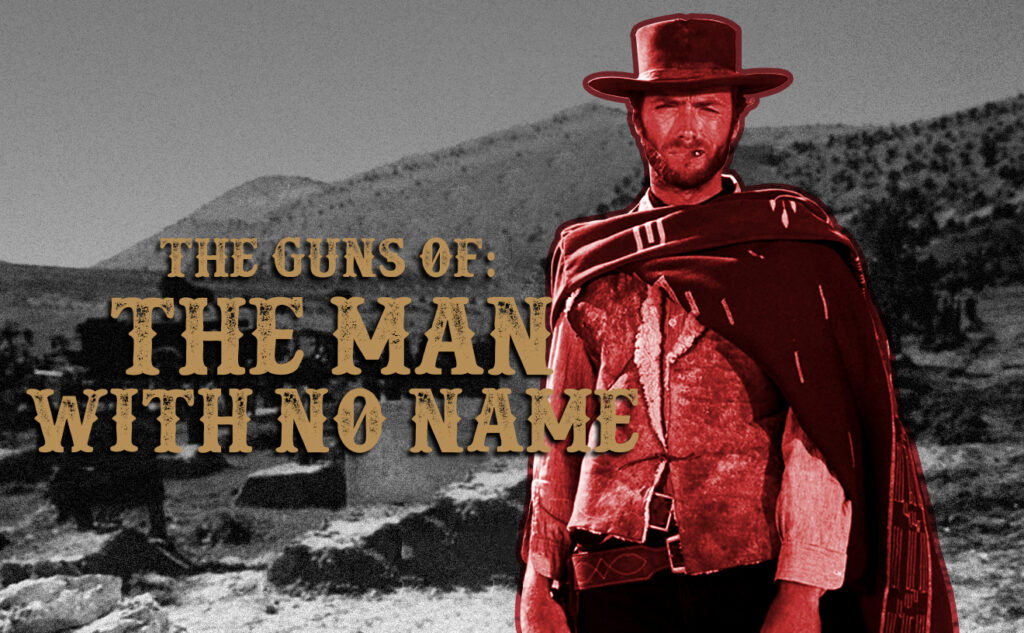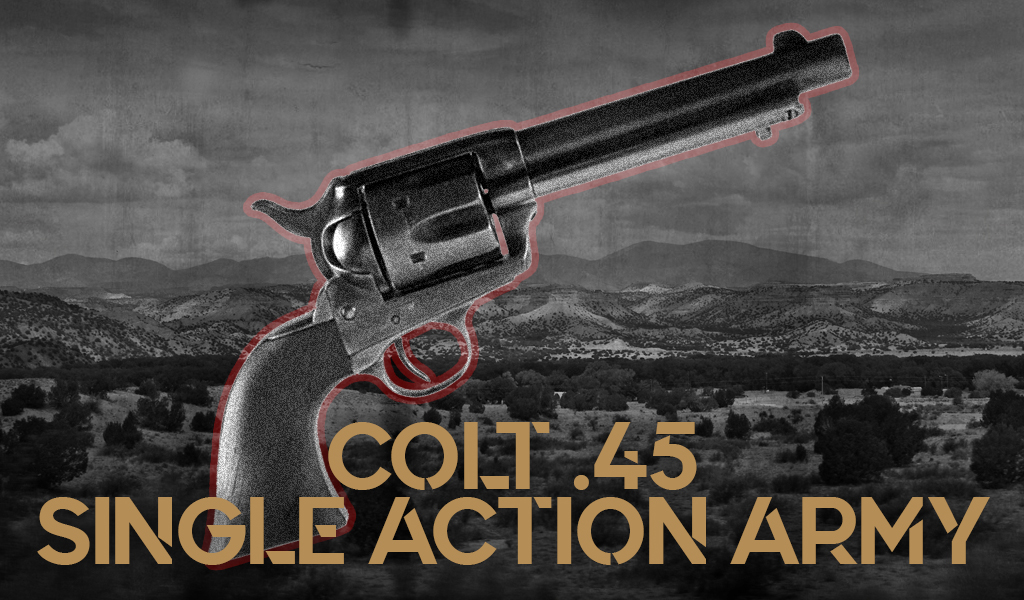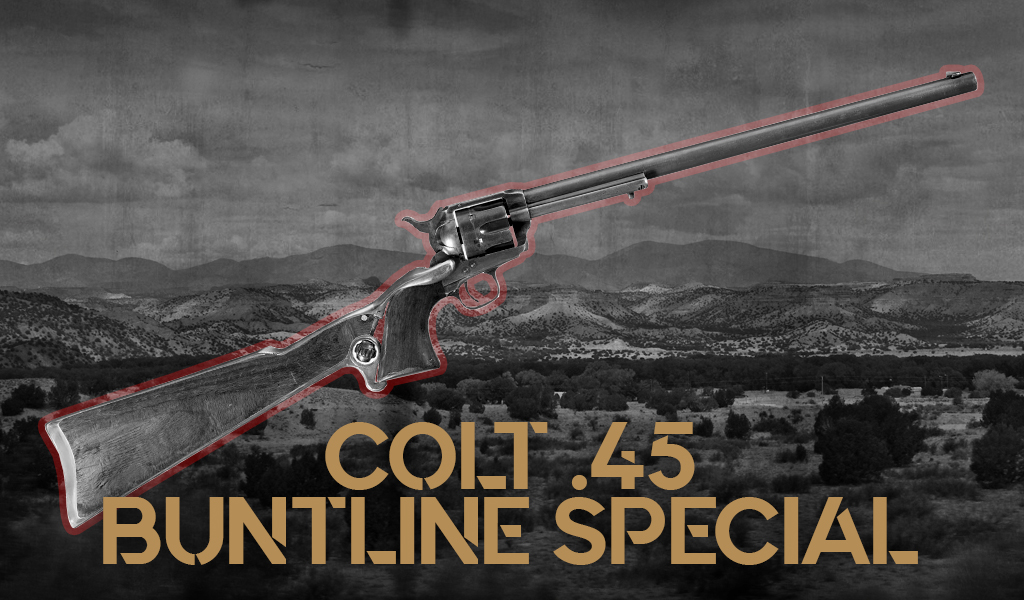https://www.wideners.com/blog/guns-of-the-man-with-no-name/SEPTEMBER 22, 2020 HISTORY

Clint Eastwood and Westerns have been a perfect match for more than fifty years. It all started with his portrayal of Rowdy Yates in the TV series Rawhide. The show ran for a total of 217 episodes from 1959 through 1966, with Eastwood starring in all of them. Clint continued his cowboy ways on the big screen with Sergio Leone’s so-called “Man with No Name Trilogy.” A series of films that set the standard for future Spaghetti Westerns (films produced in Italy and Spain) and began Eastwood’s rise to stardom.
The three films–A Fistful of Dollars (1964), For a Few Dollars More (1965) and The Good, the Bad, and the Ugly (1966)—make up the no-name trilogy. To be fair, Eastwood’s characters do have a name in each of the films. The first one, in which he’s called Joe, features an array of guns of the man with no name. He shoots a revolver, three rifles, a double-barreled shotgun, and mans a machine gun that wipes out an entire cavalry outfit. It’s set in the 1860s, and it’s vintage Eastwood as the anti-hero.
A Fistful of DollarsThe plot is fairly uncomplicated. Eastwood plays a taciturn but deadly gunfighter who rides into a small border town that has been torn apart by two rival gangs: the Rojos and the Baxters. It doesn’t take long for the stranger to show off his speed and accuracy with a gun. He effortlessly shoots four Baxter men who had insulted him as he entered the town. He then offers his services to each gang, playing one against the other and getting rich in the process.
“You shoot to kill, you better hit the heart.” – Joe (Clint Eastwood)
There is a rather high body count in A Fistful of Dollars. The Rojos gang wipes out an entire company of Mexican soldiers on horse-back (and miraculously misses all the horses). Later, they brutally murder a dozen or so Baxters, including the matriarch, as they flee from a burning building. As mentioned, Joe kills four of the Baxters and almost single-handedly destroys the Rojos clan.
Guns Of The Magnificent Stranger
a photo of a Colt 45 Single Action Army revolver
Here is a recap of the guns of the man with no name that were used to keep Piripero, the coffin-maker, busy throughout the film:
Colt 45 Single Action Army, a.k.a. The Peacemaker: It’s the only gun that Joe uses, and it’s a single-action revolver that holds six metal cartridges. The gun was originally designed for the U.S. government service revolver trials of 1872 by Colt’s Patent Firearms Manufacturing Company. It remained a standard military service revolver until 1892.
The Winchester Model 1894 Rifle: Ramon uses this lever-action .30-30 Winchester saddle-ring carbine most of the time, although he is also seen with a .38-40 Model 1892 in a few scenes. The 1894 comes with a leaf rear sight and a barleycorn-type front sight and has an internal tube magazine that holds either six or seven rounds.
J. Stevens and Company 1878 Double-Barreled Shotgun: the 12-gauge side-by-side crops up several times in the film, most notably in the hands of a Rojos brother as he attempts to shoot Joe. The 1878 has exposed hammers and fires black powder shotgun shells.
For A Few Dollars MoreIn the second installment of the Man with No Name trilogy, Eastwood plays the character Manco. He’s a bounty hunter chasing down a ruthless killer named El Indio for a dead-or-alive reward of $10,000. During the hunt, he meets another hunter, Colonel Douglas Mortimer (played by Lee Van Cleef), and the two form a partnership to kill or capture the outlaws and divide the reward money.
“Alive or dead? It’s your choice.” – Manco (Clint Eastwood)
This is another Sergio Leone movie with lots of dead bad guys (and a few dead innocents). While it’s true that you can’t put a price on life, the film shows that death is a different matter. The film ends with Manco driving his wagon into the distance loaded with the bodies of Indio and his gang members, heading out to collect $27,000 in bounty money for their remains.
Guns Of The Bounty Hunter
a photo of the Colt 45 Single Action Army Buntline Special
There are a host of weapons in For a Few Dollars More, but one of them takes center stage. It’s a unique pistol with a controversial history.
Single Action Army Buntline Special: Manco may be the cool bounty killer, but Mortimer has the coolest guns. The Colonel has two .45 caliber Buntline Specials–one with an 18″ barrel and the other has a 10″ barrel that he can fit with a shoulder stock and use it like a rifle. The pistol was named after Ned Buntline, who wrote dime novels about Western celebrities like “Buffalo Bill” Cody. Buntline reportedly commissioned the guns in repayment for “material for hundreds of frontier yarns” from these wild west celebrities. While legend has it that he traveled to Dodge City to present a Buntline Special to Wyatt Earp, there has yet to be confirmation that this ever took place or that Earp ever even used a Buntline.
Winchester 1892 Saddle Ring Carbine Rifle: Col. Douglas Mortimer carries the .38-40 caliber lever-action Winchester 1892 in his saddlebag. He uses it shoot the horse from under one of the thugs early in the film. The rifle, which has a 15-round tube magazine, is also used by some of El Indio’s outlaws throughout the movie.
Volcanic Repeater Rifle: El Indio wields a .41-caliber Volcanic Repeater rifle (firing the first Rocket Ball that contained gun powder) during the film, and Manco carries one during the duel between Mortimer and El Indio. The Volcanic Repeater rifle was part of a series of American repeating firearms produced from 1855 to 1856 by the Volcanic Repeating Arms Company. While it was considered to be the direct ancestor to the Henry rifle, the Volcanic guns were not commercially successful. The Volcanic company quickly went out of business.
The Good, The Bad, And The UglyIn the last, and arguably the best, installment in the “No Name” trilogy, Clint Eastwood once again assumes the role of the reticent dark hero. While Blondie (Eastwood) represents Good in the film’s title, he doesn’t provide much contrast to Angel Eyes (the Bad bounty hunter) or Tuco (the Ugly Mexican bandit).
“Every gun makes its own tune.” -Blondie (Clint Eastwood)
During the Civil War, these three men become rivals to find two hundred thousand dollars in buried gold coins. Tuco and Blondie already know one another, having hatched a scheme to earn bounty money by capturing and freeing the bandit. Angle Eyes hears of the gold from someone he’s been hired to kill. The three meet up in a showdown in the middle of a major battle between Confederate and Union forces.
Guns Of The Man With No Name
the colt 1851 navy Guns Of The Man With No Name
There are many casualties and enough weapons to fill several arsenals. Here are three guns of the man with no name that play a prominent role:
Colt 1851 Navy Pistol: Eastwood’s revolver still has a silver coiled snake on the grip, but the SAA from the two previous films has been replaced by a Colt 1851 Navy pistol. This model has a gate cartridge conversion kit and uses a .38 centerfire cartridge that is front-loaded and has a slight taper. Snake Eyes and Tuco carry the same pistol. The Colt gets plenty of screen time and is used to wreak an overabundance of havoc.
Sharps 1874 Rifle: As Blondie, Eastwood gets more opportunities to use a rifle. This time it’s a Sharps 1874 with ladder elevated sights and an octagonal barrel. He most notably fires off one of the .45-70 caliber cartridges to sever the rope as Tuco is about to be hanged early in the movie.
Colt 18 Gatling Gun: During a battle scene, Union soldiers are using Colt Gatling Guns. Some of the guns have 20-round vertical magazines, while others have the large cylindrical type that can hold 100 rounds. These guns are likely out of place in this film since it was set in 1862. Although the Colt Gatling was patented in 1862, the Union army didn’t buy them until 1866!
A Tin Star Is BornSergio Leone’s trilogy of spaghetti Westerns turned Clint Eastwood into an international star. His portrayal of the Man of Few Words (with No Name) set the stage for many of his future characters. Yet the guns of the man with no name are plentiful throughout the trilogy.
The contrasts in the films are groundbreaking for the genre. Exaggerated violence amid beautiful background scenery and a cynical protagonist who is not much better than the brutal thugs he is up against. Yet, these films set a standard and opened the gates for a stream of westerns. Most of which failed to join Leone at the head of the class.
The trilogy stands alone at the top echelon of violence, style, and austerity. It isn’t likely to be eclipsed anytime soon.